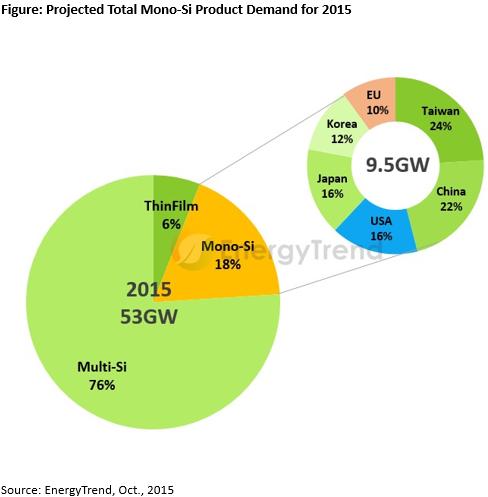Soaring demand from China, Japan and the U.S. ensures that the first-tier photovoltaic (PV) module manufacturers are booked in orders up to the first quarter of 2016. Currently, prices are rising for all multi-Si products from wafers to cells and modules, with wafers having the largest increase due to news of supply shortages. On the other hand, the mono-Si market has not benefited from the sharp rise in demand during this year’s second half. Corrine Lin, analyst for EnergyTrend, a division of TrendForce, said that while the global mono-Si wafer capacity has exceeded 14GW in 2015, this year’s annual demand in the mono-Si end market is projected to be under 10GW. Trades of mono-Si products have remained weak as supply outstrips demand.

Nonetheless, demand of mono-Si products will warm up next year, as they become more accepted in the PV power plant market. Furthermore, PV cell manufacturers have expanded the adoption of the passivated emitter rear cell (PERC) technology and found that PERC produces better efficiency results on mono-Si cells than on multi-Si cells. PERC solutions from different companies are expected to drive the mono-Si market next year when they have become more mature. Though mono-Si products are currently in severe oversupply, their share within the overall product mix will gradually increase starting this year. Furthermore, mono-Si wafer manufacturers have plans to significantly expand their capacities in the next year or two, and the global mono-Si wafer capacity is projected to increase by 20% in 2016.
Price slump continues in the mono-Si wafer market while the multi-Si market benefits from soaring orders
The N-type mono-Si wafer market has been relatively calm compared to the P-type mono-Si wafer market, which has seen greater price competition. Because of a serious supply glut, the average price of mono-Si wafers has kept falling from US$1.04/pc at the start of this year to the current price of US$0.92~0.93/pc. Though the demand-supply situation appears to stabilize for now, price rebound is unlikely and profit margins will stay low. Low mono-Si wafer prices also drive down the costs of mono-Si cells. In China, for instance, some mainstream mono-Si cell products are now at around RMB 2.35/W, matching the prices of multi-Si cells for the first time. This also indicates that module companies are now able to make mono-Si products with high cost-performance ratios.
According to EnergyTrend’s latest price forecast, the multi-Si wafer market has reached a rare state of equilibrium due to a surge of orders from the cell manufacturers. Consequently, multi-Si wafer suppliers have raised their prices in October, starting with leading polysilicon and wafer supplier GCL. Currently, multi-Si wafer prices have reached RMB 6.15/pc in China and are moving towards US$0.84/pc in Taiwan. In the mono-Si cell market, only a few module manufacturers are sending out orders. Mono-Si cell demand is also supplemented by orders outsourced from some larger PV enterprises. EnergyTrend concludes that while mono-Si wafer demand remains weak, but suppliers will likely develop more proactive pricing or business strategies to extend the market shares of mono-Si products.





